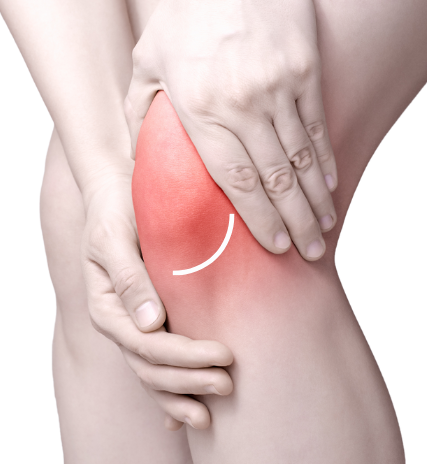KNEE MENISCUS TEAR
What Causes Knee Meniscus Tear?
The meniscus is a hard rubber-like cartilage in the knee that absorbs shocks. They can be damaged by a sudden pivot or a hard tackle from football, these injuries can cause the meniscus to rupture.

What Causes Knee Meniscus Tear?/h3>
Knee meniscus tear are primarily caused by sports such as football, basketball and tennis, these sports cause direct trauma to the meniscus. Old age and degeneration also cause knee meniscus tears.
Risk factors for Knee Meniscus Tears include:
- Contact Sports
- Prior injury
- Improper techniques and jumping
Symptoms Of Knee Meniscus Tear
Knee Pain
Pain in the knee joint may be one-sided and may worsen when there is additional pressure. Pain from an acute meniscal tear is difficult to differentiate from chronic tear syndrome.
Stiffness
Joint stiffness and pain may affect the knee joints and impede your daily functions. This includes tasks such as walking, bending, going up or down the stairs, wearing trousers or getting out of the car.
Swelling and Tenderness
Knee Meniscus Tears can result in swelling of the affected region.
Instability or Locking
Your knee feels as though it is giving out, occasionally, it may also lock in place.
A Message About Knee Meniscus Tear
Knee pain arising from a Meniscal tear is usually sharp and debilitating. The patient may have difficulty weight bearing, standing, or walking. While meniscal tear is often associated with trauma and injuries, degenerative knee changes can result in chronic mucoid tears of the meniscus without any obvious trauma to the knee.
Once the meniscus is torn, it is often difficult to repair or grow back the meniscus. Even with surgery, the torn meniscus is often cut away to prevent further extension of the tear into its surrounding meniscus. If its supporting tibial bone presents with subchondral oedema, from the exposed torn meniscus, it will take 4 – 6 weeks of non-weight bearing rest for the affected knee.
PRP injection into the knee may increase the chance of fibrosis and scarring of the tear. It can provide good pain relief. However, the knee may not be as stable as it used to be. In severe cases of tears in a degenerated knee, open total knee replacement may be the treatment option.
Diagnosing Knee Meniscus Tear
Non-Surgical Treatment for Knee Meniscus Tear
Physical therapy
The therapy sessions by our specialists involve both aerobic and resistance training to reduce pain. However, the intensity and type of exercise may differ based on the conditions of the patient.
Non-steroidal anti-inflammatory drugs (NSAIDs)
NSAIDs may be prescribed to help minimize pain and swelling.
Knee brace
Knee braces may be used temporarily to limit the movement of the knee and provide support, this can effectively reduce pain or stimulation of the inflamed muscles.
Platelet-rich plasma (PRP)
Platelet injections are commonly used for pain caused by a torn meniscus as well as conditions such as osteoarthritis. The injection sites include the meniscus and surrounding ligaments.
Myospan treatment addresses both local and referred causes. Our Coreflex injections use a mix of local anaesthetic, anti-inflammatory and muscle relaxant, to be injected into the affected knee as well as any strained surrounding meniscus and ligaments.
Surgical Treatments for Knee Meniscus Tear
If the condition does not respond well to conservative treatments surgery may be needed. Surgeries always come with associated risks, complications and downtime – they may not be suitable for everyone.
Knee replacement surgery
Arthroscopic surgery may be done to repair the damaged tissue. This surgery may entail cutting off the torn meniscus (meniscectomy). The procedure involves making a small incision in the knee to insert a micro camera and surgical devices. After the surgery, patients should be able to go home the same day.






